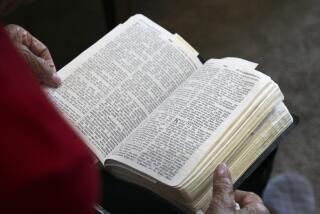A Library Where Every Book Tells Same Story
- Share via
PHILADELPHIA — In a dim basement at LaSalle University, dark wood bookshelves line a back wall, filled with thousands of pages of the same story.
Some books are written in English, others in Latin and Arabic. Some pages are illustrated with intricate engravings, handmade of wood more than four centuries ago. Rolled in ink, they were pressed onto the books’ pages of cloth or lambskin.
More than 200 Bibles dating to the 1400s make up the university’s collection, which includes copies of some of the rarest Bibles in North America.
The university, founded by the Christian Brothers in 1863, has an enrollment of about 5,000 undergraduates and graduates. The campus is squeezed between row houses and pizza shops a few miles from downtown.
Brother Daniel Burke, who founded the basement art gallery that houses the collection, keeps watch over the books. Exhibitions in the gallery often showcase the Bibles’ exquisite illustrations, normally sequestered on a large bookshelf.
LaSalle’s English majors rely on the collection when they study the history of books, and their interest delights Burke. “It’s enough to work with the students,” he said.
The collection’s centerpiece is a 1535 Coverdale Bible, the first complete English translation published using the printing press. LaSalle’s copy is one of only a handful of the first editions in North America.
*
LaSalle’s edition is missing only eight pages. The pages in the leather-bound book have not yellowed; indeed, the edges are still gilt, and the black ink is still dark.
Its namesake, Miles Coverdale, did the translation from Latin and German. Flipping through the pages, Burke said he is still amazed at how the translation matches modern versions.
LaSalle’s collection also includes two first editions of the King James Bible from 1611--weighing 20 pounds each, they are positioned on the library’s lowest shelf.
Liana Lupas, a curator of the scripture collection at the American Bible Society in New York City, appreciates the rare edition. “For the first time,” she said, “the complete English Bible became available in print.”
More delicate books, with yellowed pages and frayed bindings, are kept under cover. The Quincuplex Psalterium, a first edition from 1509, is stored in a maroon leather box lined with green silk.
Before the printing press, scribes created Bibles by writing each word by hand. Rare and expensive, the books were often chained to lecterns to avoid theft. Smaller books, such as the palm-sized ones that make up the Medieval Books of Hours, were used during private prayer services in 1475.
Originally a history of early Bible illustrations, LaSalle’s collection now includes modern editions and many translations from the last five centuries. The Gospels in Arabic and Latin, from 1591, was the first Bible ever translated into Arabic.
With little funding, the university relies on donations for the collection and obtains many of the books through auctions.
A corporate donation, for example, enabled the university to acquire the Coverdale bible at a 1980 auction at Sotheby’s for tens of thousands of dollars. “The Lord is good to poor but persistent collectors,” Burke said with a smile.
The collection began 20 years ago with a donation from Tim Dunleavy in memory of his daughter, Susan, a student who died in a car crash in 1977. The collection now bears Susan Dunleavy’s name.
Burke considers himself fortunate to be near such books: “It’s a great intellectual lesson. You’re learning something all the time.”
More to Read
Sign up for our Book Club newsletter
Get the latest news, events and more from the Los Angeles Times Book Club, and help us get L.A. reading and talking.
You may occasionally receive promotional content from the Los Angeles Times.






